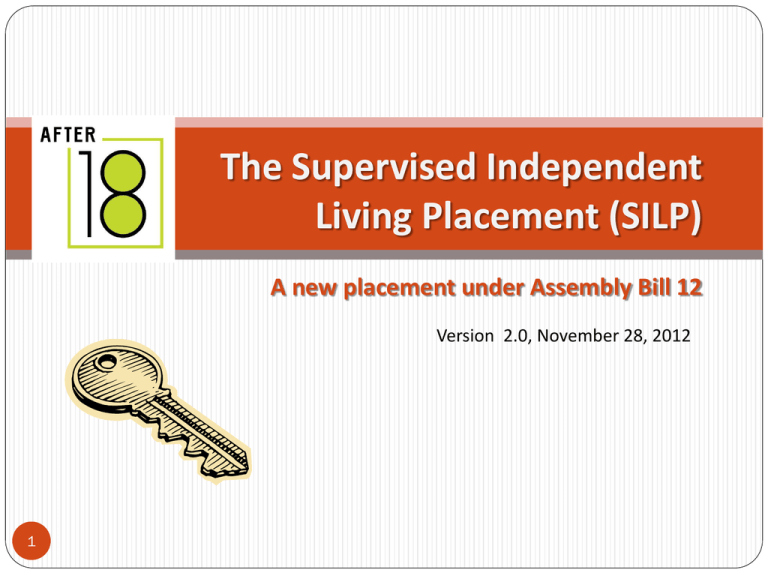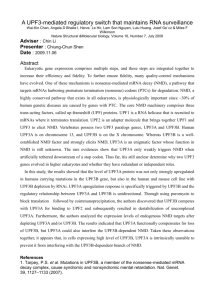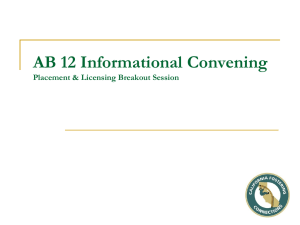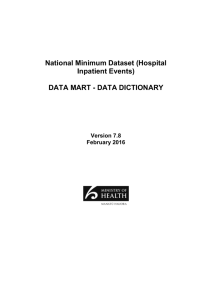
The Supervised Independent
Living Placement (SILP)
A new placement under Assembly Bill 12
Version 2.0, November 28, 2012
1
Agenda
Introduction to the SILP
Completing the Readiness Assessment
Completing the Physical Inspection
Completing the Approval & Placement
Agreement
Shared Living & Shared Living Agreements
Other Considerations: Parenting NMDs
Helping NMDs Plan for the Future
2
Ice Breaker: Share with Group
What was your
worst
roommate/shared
living experience?
3
How did you
handle it?
Introduction to the SILP
Least restrictive placement
setting under extended care
4
Introduction to the SILP
What the SILP is:
A placement for young adults developmentally ready to
live independently or in a less restrictive environment
A placement that will most often consist of shared living
5
What the SILP is not:
An emergency placement for NMDs lacking suitable
placements
A placement for “hard to place” NMDs
A placement for NMDs requiring significant supportive
services
A placement for NMDs with high risk mental/physical
health needs
Monthly Benefit
Limited to the basic rate ($776/month)
NMDs can receive the foster care benefit
directly
Clothing allowance available
Parenting NMDs receive the infant
supplement ($441/month)
Specialized care increment not available
6
Role of SW/PO
Social Worker/Probation Officer Responsibilities:
Conduct a readiness assessment of NMD
Include areas of needed improvement identified in
readiness assessment in NMD’s TILP
Provide guidance to NMD about selecting appropriate
roommate(s) and appropriate housing site
Complete a SILP Approval & Placement Agreement
Meet with NMD once per month
Ensure a physical inspection of identified housing unit is
conducted (by SW/PO or another county authorized entity)
7
Role of NMD
Non-Minor Dependent Responsibilities:
Locate/identify housing
Notify SW/PO of interest in SILP
Prepare financial information/budgeting materials to
provide for SW/PO during readiness assessment
Apply for or make arrangements for securing housing
Select roommate(s) (with guidance from SW/PO)
Meet with SW/PO once per month
Notify SW/PO of changes in housing status (i.e. change in
roommates)
Maintain housing (paying rent & bills, housekeeping, etc.)
8
Types of Housing for SILPs
Private Market HousingApartments
Renting a Room
Single Room Occupancies (SROs)
Dorms / University Settings
9
Getting Started
NMD is
interested in
living in a SILP
NMD
approaches
SW/PO with a
place to live in
mind
SW/PO
conducts
readiness
assessment
If NMD needs assistance with finding housing, SW/PO can provide him/her
with Young Adult’s Guide to Housing, but also may want to have conversation
with NMD about who he/she already knows that he/she may be able to live
with (former caregiver, permanent connection, etc.)
10
Readiness Assessment
Required for all NMDs in SILPs except those in
student approved housing/dormitories
NMD & SW/PO should work together to assess
readiness
Some SILP types require more independence
than others
11
Readiness Assessment
Purpose & Components
To assess whether NMD • can afford identified housing
has a feasible financial
• has stable income
plan
To assess whether NMD
• e.g budgeting, managing money
has knowledge of
financial skills
To assess whether NMD
is developmentally ready • e.g grocery shopping, preparing
meals, self care, paying bills,
to handle daily tasks on
transportation, etc.
their own
12
To assess whether NMD • e.g. waking up in time for work or
school, stress/anger management,
has the ability to handle
decision-making
independence
Readiness Assessment
Assessment Tool
Social Workers and Probation Officers must use a tool
Tools suggested by DSS
Ansell Casey
Daniel Memorial
Other nationally recognized tools approved by the
state and used by counties to approve TILP
assessments
13
Help with Budgeting
Helpful tools for NMDs who express need for
assistance with preparing his/her budget for readiness
assessment:
Budgeting tool included in Young Adult’s Guide to
Housing
Online budget tool:
http://www.californiarealitycheck.com/
Select option 1: Reality Check
Tool is great for NMDs to explore housing costs in
their county
14
Readiness Assessment
Budgeting and Money Management
Assesses youth’s ability to pay rent/bills
Experience with banking and responsible
spending
Ability to budget and manage funds
15
Readiness Assessment
Tenant Rights and Responsibilities
Whether NMD understands their lease (if applicable)
Whether NMD knows their rights as a tenant
Whether NMD is aware of their responsibilities as a
tenant
Ability to handle daily tasks
Whether NMD can prepare food and do laundry
Ability to use transportation
Ability to access resources and obtain medical care
16
Readiness Assessment
Ability to handle independence
Is the living environment safe
Can the youth manage time?
Understanding of healthy behavior (safe sex,
pregnancy prevention, drinking, proper use of
medications, medication side effects)
Managing conflict and relationships
17
Readiness Assessment
Possible assessment outcomes
Ready
Ready with assistance
Not ready (goals incorporated into TILP)
Basis for assessment
Determination of payee
18
Readiness Assessment
Denials
Examples
of
reasons
for
denial:
19
• Rent & utilities exceed income
• Unstable income
• No knowledge of how to
manage money
• Unable to care for self without
assistance due to a medical or
mental health condition (as cited
in ACL 11-77)
Readiness Assessment
Next Steps
NMD
determined
ready
Readiness
Assessment
completed
Reason for denial
documented on
assessment
NMD
determined not
ready
20
SW/PO conducts
Health & Safety
Inspection
Areas of
improvement
turned into goals
on NMD’s TILP
NMD can be
reassessed at a later
set date
Readiness Assessment
Denials: Grievance Process
If SW/PO determines after readiness assessment that
NMD is not ready for a SILP, NMD has right to a
grievance process if he/she disagrees with SW/PO
No standard process; each county may use own
If NMD is still not satisfied with outcome of grievance
process or doesn’t want to use county grievance process,
he/she can bring issue in court
21
Activity
22
SILP Physical Inspection
10-item SILP health & safety walk-through and checklist
23
must be performed on all SILPs except university/college
approved housing
Inspection should be arranged with NMD so that it respects
NMD’s privacy and schedule (including that of roommates)
NMD allowed to live in a SILP that has not yet been approved
temporarily
County must inspect a new SILP within 10 calendar days
SILP unit must be re-inspected annually
Copy of completed checklist should be provided to NMD
SILP Healthy & Safety Checklist
24
SILP Physical Inspection
Section A: SILP Placement Type
University/College Approved Housing
Physical inspection does not need to be conducted
Shared Roommate Setting, Single Resident
Occupancy (SRO), Apartment, Room and Board,
Room Rental
Physical inspection needs to be conducted
SILP on or near a reservation, approved by the
25
tribal placing agency
Physical inspection needs to be conducted, but there are
areas that may be exempt where indicated on the checklist
Physical Inspection
Section B: Safety Checklist
Checklist completed during walk-through of unit with NMD
10 items on list – each must be marked with “yes” meaning item
is acceptable, or “no” meaning item is not acceptable
If repairs are needed, but item does not pose safety risk, item can be
marked “yes” with an “x” in the “Maintenance Noted” column with list of
the maintenance issue(s) in section C of form.
If conducting inspection of tribal housing, circle “Tribal waiver” for those
items that are exempted.
→ THE FOLLOWING SLIDES PROVIDE CLARIFICATION
ON EACH ITEM ON CHECKLIST (as defined by HUD
Quality Standards)
26
Physical Inspection
Section B: Safety Checklist
Directly from form:
1. Bedroom/Sleeping area: Bedroom/sleeping area used by the young
adult has at least one exit that ensures safe, direct, emergency exit to
the outside. If security bars are installed on windows, the window is
considered operable only if equipped with safety release devices.
________________________________________________________
HUD HQS Definition/further clarification:
“emergency exit to outside” could be a door or a window that
leads directly to the outside, not to a hallway or another part of the
building. If not on first floor, there must be a safe way to exit such as
fire escape, ladder or stairs.
“safety release devices” are a way to release bars from a window
so that an open window can serve as an exit
27
Physical Inspection
Section B: Safety Checklist
Directly from form:
2. Home has indoor sprinkling system and/or functioning smoke detector
installed in the hallway(s) of the young adult’s sleeping area audible in each
room or sleeping room used by the young adult.
______________________________________________________
HUD HQS Definition/further clarification:
“indoor sprinkling system” – will most likely not have a system, but
will have smoke detector.
“functioning smoke detector” – test by pressing the test button (if
battery needs to be replaced, detector will make chirping sound).
28
Physical Inspection
Section B: Safety Checklist
Directly from form:
3. Bathroom: Young adult has access to a bathroom that contains 1 toilet, 1
sink, and 1 tub or shower maintained in safe, operating condition free from
health hazards.
________________________________________________________
HUD HQS Definition/further clarification:
“maintained in safe, operating condition free from health hazards”
Toilet must flush
Sink must have cold and hot running water and a sink trap
Tub/shower must have proper sewer trap, drain, vents, cold/hot running water
Drains must not be clogged
No broken ceramic, metal or glass fixtures that may pose a hazard (i.e. mirror,
29
towel rack, soap dish, medicine cabinet, etc.)
A faucet with a hot water leak can be a scalding risk
Physical Inspection
Section B: Safety Checklist
Directly from form:
4. Kitchen: If applicable, the young adult has an area to prepare meals, appliances are
safe, operational, with adequate storage for food and is free from health hazards.
Note: SRO’s may not have standard kitchens.
________________________________________________________
HUD HQS Definition/further clarification:
“appliances are safe, operational” – Oven must heat. Stove/range knobs
30
must be present. Refrigerator must be capable of maintaining a temperature low
enough to keep food from spoiling (above 32 F but generally below 40 F). Sink
must have a sink trap and hot and cold running water.
“free from health hazards” – gas leaks, electrical hazards
“SRO’s may not have standard kitchens” – an SRO may be located in a
building that has shared kitchen space, or SRO may have a kitchenette or a small
area for some basic appliances.
Physical Inspection
Section B: Safety Checklist
Directly from form:
5. Indoor and outdoor halls, stairs, ramps and porches are free from
obstructions and no structural damage that poses a safety hazard is
observed.
________________________________________________________
HUD HQS Definition/further clarification:
“structural damage that poses a safety hazard” – serious defects
such that the structural safety of the building is threatened, such as severe
buckling, bulging or leaning; damaged or loose structural members; large
holes; air infiltration. stairs, porches, balconies, or decks with severe
structural defects; broken, rotting, or missing steps; absence of a handrail
when there are extended lengths of steps (generally four or more
consecutive steps); absence of or insecure railings around a porch or
balcony which is approximately 30 inches or more above the ground.
31
Physical Inspection
Section B: Safety Checklist
Directly from form:
6. Home has adequate and functioning ventilation including
heating systems.
____________________________________________
HUD HQS Definition/further clarification:
“adequate and functioning ventilation” – opening
windows or cooling system; heating equipment capable of
providing adequate heat (either directly or indirectly) to all
rooms used for living
32
Physical Inspection
Section B: Safety Checklist
Directly from form:
7. Lighting and outlets are provided in rooms used by the young adult
and no electrical hazards are present.
___________________________________________________
HUD HQS Definition/further clarification:
“Lighting and outlets” – There at least two working outlets or
one working out let and one working, permanently installed light
fixture. Test by plugging something in to see if it works.
“electrical hazards” – are defined by broken, non-insulated or
frayed wiring; or improper types of wiring, connections or
insulation.
33
Physical Inspection
Section B: Safety Checklist
Directly from form:
8. Waste is stored, located and disposed of in a manner that will not
permit the transmission of communicable disease or odors, create a
nuisance, or provide a breeding place or food source for insects or
rodents.
___________________________________________________
HUD HQS Definition/further clarification:
Facilities and services for the sanitary disposal of food waste and
refuse, including temporary storage facilities where necessary, are
required.
34
Physical Inspection
Section B: Safety Checklist
Directly from form:
9. Living space appears to be safe and free from hazards.
____________________________________________
HUD HQS Definition/further clarification:
If any other defects that present a safety hazard are
observed during the course of the inspection that are not
addressed by other sections, they should be noted here
35
Physical Inspection
Section B: Safety Checklist
Directly from form:
10. Sleeping room has not more than two adults and is not a kitchen or
a bathroom. Waiver may be granted for more than two adults if there
is a clear and direct path for each adult to exit the room in case of
emergency and if there is adequate storage for each adult’s clothing
and personal items.
___________________________________________________
HUD HQS Definition/further clarification:
“clear and direct path for each adult to exit” – each adult
should be able to walk from their bed or personal area to the exit
without having to step over furniture or obstructions.
36
Physical Inspection
Section B: Safety Checklist
Items marked in Section B as “NO” indicate deficiencies
that would have a direct and immediate risk to the health,
safety or personal rights of the young adult.
Correction must be made prior to the placement of the
young adult or the home may not be approved.
Examples of Immediate Impact Deficiencies:
37
Infestation of insects or vermin
Exposed electrical hazards
Black mold
No functioning smoke alarms in unit
Toilet not in working condition
Physical Inspection
Section C: Maintenance or Repair Plan
This section is where person conducting inspection should
record any maintenance issues in need of repair, such as:
Neglect of maintenance of the building and grounds
Cracked window
Peeling paint or wall paper, or stained walls or flooring
These are issues that ARE NOT considered safety or health
issues, and are not cause for denying approval of housing
38
Physical Inspection
Section D: Inspection Summary
The Supervised Independent Living Placement of _____________
(young adult name) meets the standards for approval as described in
this form.
The Supervised Independent Living Placement of _____________
(young adult name) meets the core safety and health standards for
approval with the above recommended maintenance or repair issues
noted.
The Supervised Independent Living Placement of _____________
(young adult name) does NOT currently meet the standards for
approval.
Young adult indicated he/she will pursue needed corrections and has
requested re-inspection of unit in ___ days.
39
SILP Approval &
Placement Agreement
Housing
identified
40
Readiness
Assessment
conducted
Health &
Safety
Inspection
conducted
Approval &
Placement
Agreement
completed
SILP Approval & Placement
Agreement
41
SILP Approval & Placement Agreement
Components
1.
2.
3.
4.
5.
6.
7.
8.
42
Placement Type
SILP Readiness
Parent with Infant Supplement
Payment
Other Persons in Shared Housing Unit
Reporting
Health & Safety Inspection
Signatures
Shared Living
Most NMDs in SILPs will reside in a shared
living arrangement – may consist of:
Living with roommate(s)
Living with former caregiver(s)
Renting a room from a stranger
43
Shared Living Agreements
Shared Living Agreements (SLAs) are a best practice
SLA is a basis for a written understanding between the NMD
44
and former caregiver or others with whom the youth is residing.
Should be broad in scope, covering aspects of shared daily living
Each SLA should be individualized, reflecting specific values,
concerns and personalities of all parties
SLA should support the NMD’s continued transition into
adulthood
SLA should be renegotiated and updated as needed and
appropriate
SLA with roommate(s) is also something for NMD to consider
Shared Living Agreements
Shared Living Agreements may include the following topics:
Mentoring/Skills/Interests
Household Agreements and Customs
Healthy and Safety Concerns
Household Chores and Responsibilities
Attendance and Performance at School and or Work*
Financial
Drugs and Alcohol
Conflict Resolution
* This would most likely not be included on a SLA between a NMD and
roommate(s)
45
Shared Living
Activity
Scenario: Mia lives with her former foster mother, Linda as
a SILP placement. When Mia lived with Linda as a minor,
Linda was very strict about school and would ground Mia if
she missed a day or was late to school. Mia is now 18 and
takes courses at a community college. Mia recently stayed
out until midnight on a Sunday night and was too tired to
attend class the next morning. Linda told Mia that because
she missed class she was grounded the following weekend
and that she could no longer go out on a Sunday night.
46
Helping NMDs
Select Roommate(s)
SW/PO is responsible for guiding NMDs about how to select
appropriate roommates/housemates
Refer to handout “Selecting Roommates” to review areas of
consideration with NMD such as:
Sharing space
Personal habits
Money
SW/PO cannot perform background checks on roommates
NMDs may choose to ask for a background check from roommate(s)
Megan’s Law website - online resource to check if someone is a registered sex
offender – http://www.meganslaw.ca.gov/
47
Other Considerations:
Parenting NMDs
Consider including assessment of NMD’s ability to provide adequately
for child when conducting Readiness Assessment Is NMD budgeting adequately for child-related expenses?
Is NMD’s childcare plan realistic, convenient and safe?
Is NMD capable of daily care? (feeding, supervising, addressing health needs)
Is NMD considering appropriate roommates?
Helpful resources for determining whether NMD is capable of living
independently with child:
Ansell Casey Life Skills Parenting Young Children Assessment Supplement
Ansell Casey Life Skills Parenting Infants Children Assessment
Ansell Casey Life Skills Assessment Supplement - Pregnancy
48
Physical inspection - consider health and safety of NMD and child
Other Considerations:
Parenting NMDs
Shared living that includes a child requires additional
considerations:
quiet times for naps
no smoking in apartment
no leaving dangerous objects in child’s reach
will roommate(s) ever provide baby-sitting?
will parenting NMD pay more than non-parenting NMD in rent
or for bills/groceries?
Important to discuss with non-parenting NMD what to
49
expect if choosing to live with a roommate with a child
If NMD is living with former caregiver, consider completing
a Shared Responsibility Plan in addition to SLA
Searching for, Establishing &
Maintaining Housing
Make sure to provide NMD with Young Adult
Guidebook in your training packet
Guidebook provides resources and direction on:
Budgeting
Searching for housing
Applying for housing
Getting established
Maintaining housing
50
Planning for the Future
How Can You Continue to Help?
Provide NMDs with information on affordable housing early
Get them on the wait lists ASAP!
Serve as a reference for rental applications after NMD emancipates
Help NMD order a credit check prior to emancipation – a landlord
will often accept a copy
Help NMDs with criminal records get copies of their records
So they can prepare to respond to questions and background searches
To help them determine the impact of their record on housing
eligibility
Help young people seal their juvenile records or have them
expunged
51
Planning for the Future
Affordable Housing
Affordable housing options after discharge from care:
Public housing (i.e. Section 8, FUP vouchers)
Nonprofit or privately managed affordable housing (i.e.
52
transitional, permanent)
Employment and training with housing attached (i.e. Job
Corps)
Student housing
Tribal housing
Housing and programs for those with special needs (i.e.
young parents, mental illness)
Planning for the Future
Benefits & Resources
Benefits and resources to help young people sustain housing
Food assistance
CalFRESH, WIC, local food banks
Income subsidies
SSI, Tribal enrollment benefits
Move-in money to help with deposits and first/last month
rent requirements
Chafee monies, Funds from community organizations and agencies
Free or discounted furniture, household supplies and
equipment
53





